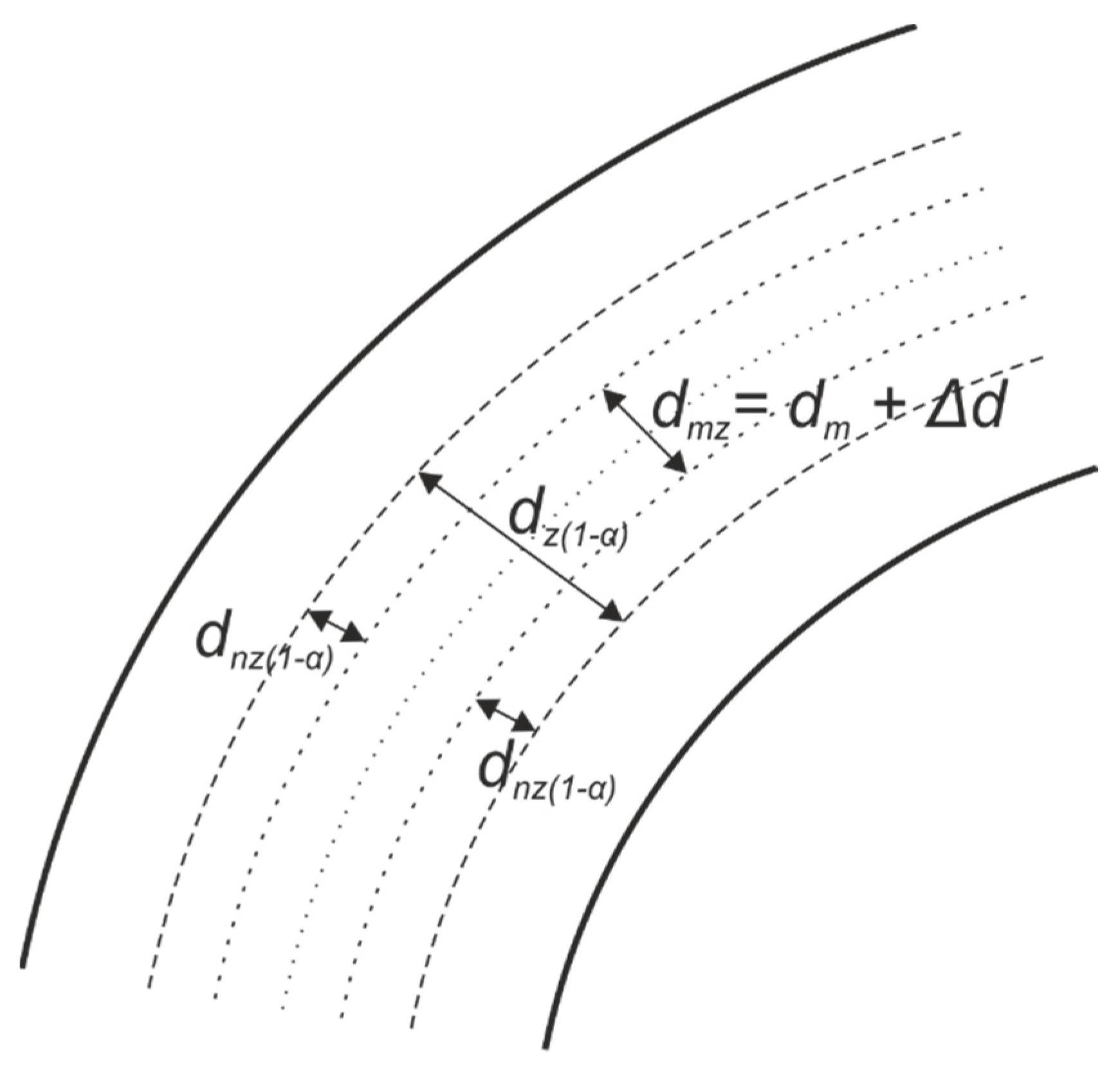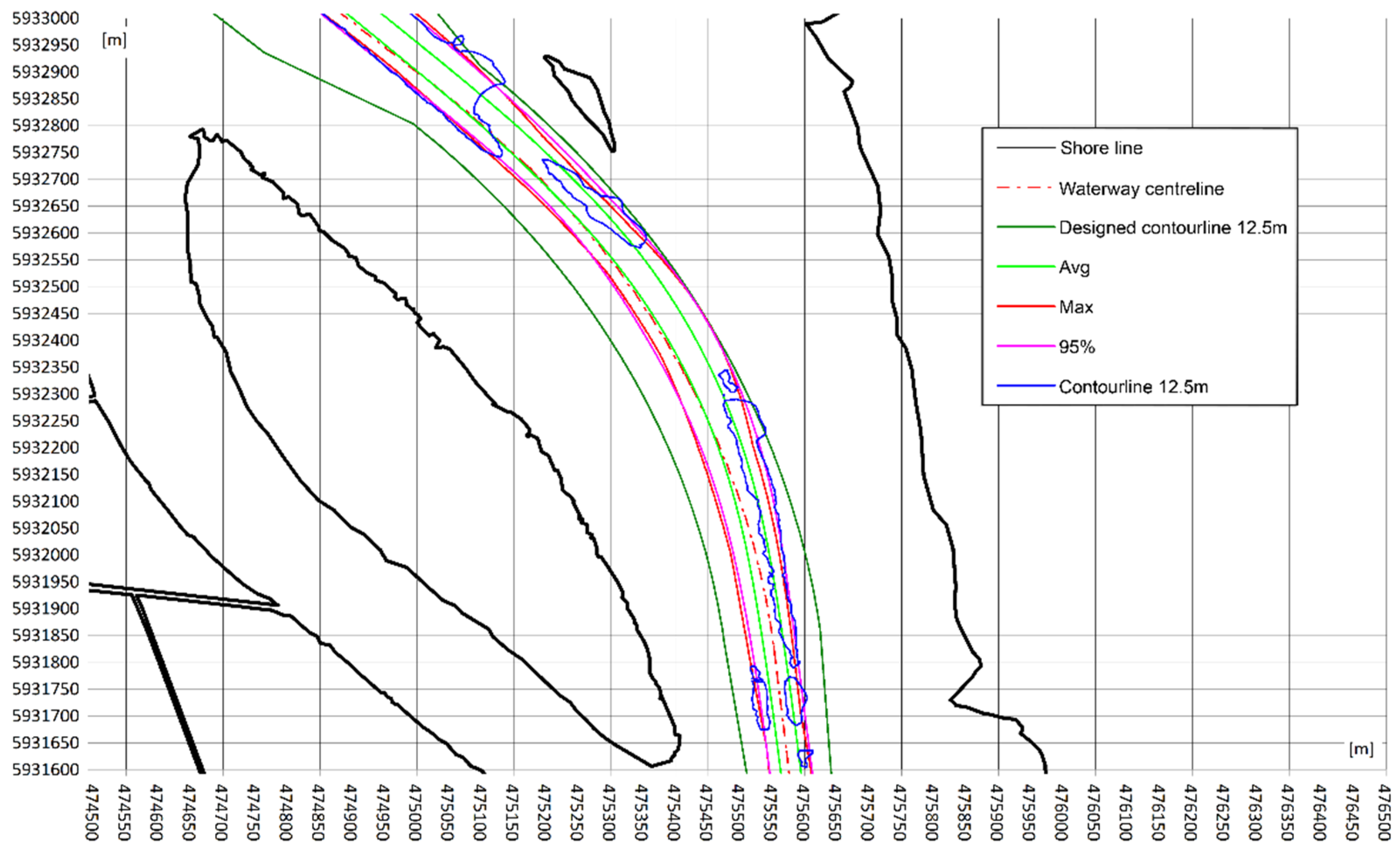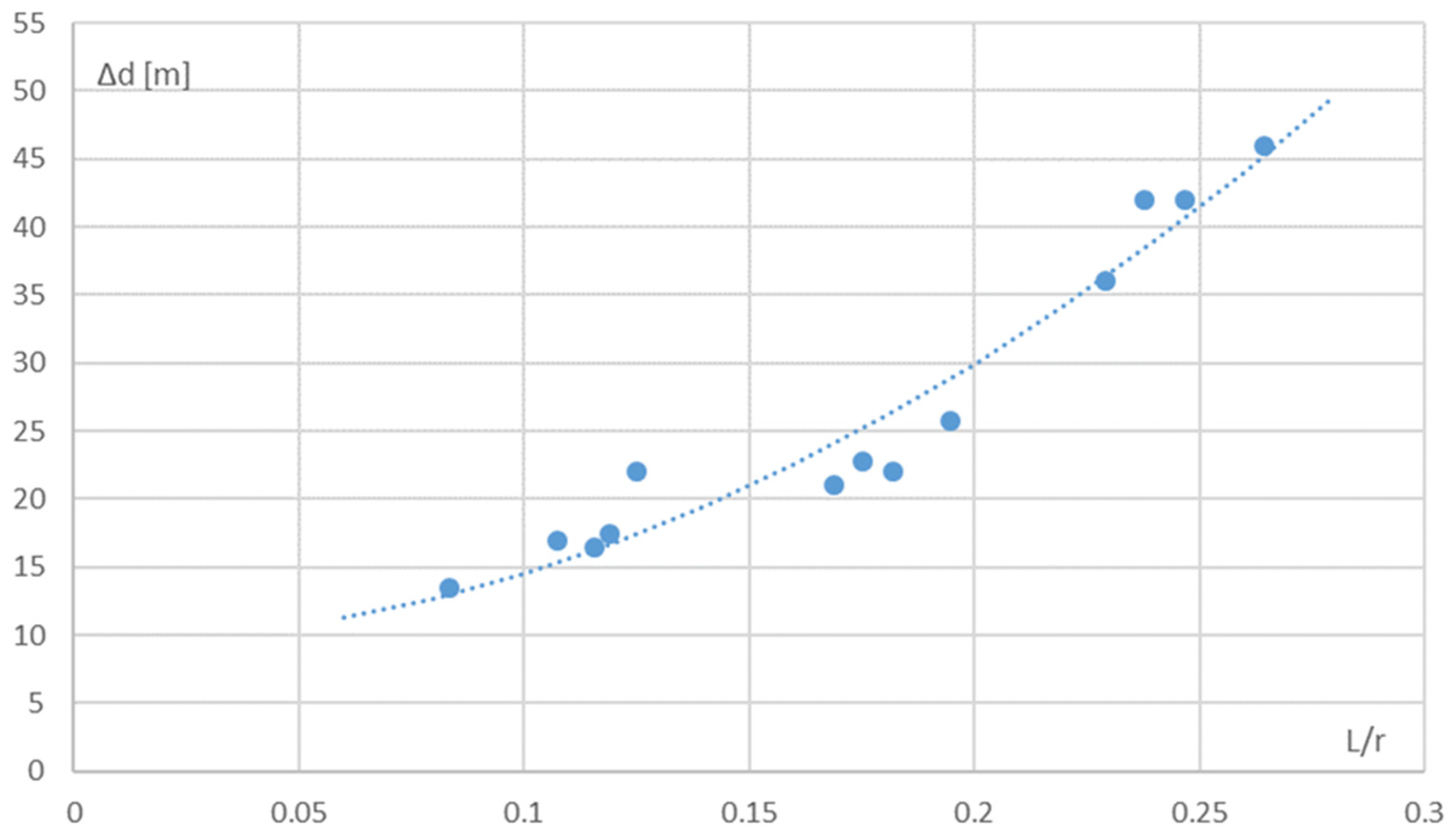Generalized Method for Determining the Width of a Safe Maneuvering Area for Bulk Carriers at Waterway Bends
Abstract
:1. Introduction
- The World Association for Waterborne Transport Infrastructure—PIANC;
- Recommendations for Maritime Works—ROM (Spanish);
- Japanese;
- Centrum Inżynierii Ruchu Morskiego—CIRM.
- At the bends of the fairway, statistically insignificant differences for both bulk carriers and cruise ships were shown only by the CIRM method.
2. Research Method
- Bulk carriers:
- LOA = 300 m, B = 48.1 m, T = 13.5 m Cb = 0.81;
- LOA = 280 m, B = 45.0 m, T = 13.5 m Cb = 0.82;
- LOA = 270 m, B = 41.5 m, T = 13.0 m Cb = 0.82;
- LOA = 260 m, B = 40.0 m, T = 12.8 m Cb = 0.82;
- LOA = 200 m, B = 29.0 m, T = 11.0 m Cb = 0.83;
- Tanker (LPG carrier ROM): LOA = 250 m, B = 38.3 m, T = 11.0 m Cb = 0.82.
3. Results
- Coefficient of determination: R2 = 0.9435;
- Standard deviation of the residual components of all observations: δ13 = 2.7533.
4. Discussion
5. Conclusions
- detailed designs of fairway bend parameters;
- determining the conditions for the safe operation of vessels on existing waterways.
Author Contributions
Funding
Institutional Review Board Statement
Informed Consent Statement
Data Availability Statement
Conflicts of Interest
References
- Artyszuk, J.; Gralak, R.; Gucma, M.; Gucma, S.; Ślączka, W.; Zalewski, P. Optimization of waterway bend widths using computer simulation methods of ship movement. Sci. J. Marit. Univ. Szczec. 2016, 46, 115–121. [Google Scholar]
- Bian, X.; Yan, Q. Determining the Width of Bend Channel for Very Large Vessels Based on Simulation Trials. In Proceedings of the ICTIS 2013: Improving Multimodal Transportation Systems-Information, Safety, and Integration, Wuhan, China, 29 June–2 July 2013; pp. 2250–2256. [Google Scholar]
- Quy, N.M.; Vrijling, J.K.; Van Gelder, P.H.A.J.M. Risk-and simulation-based optimization of channel depths: Entrance channel of Cam Pha Coal Port. Simulation 2008, 84, 41–55. [Google Scholar] [CrossRef]
- Amendola, J.; Miura, L.S.; Costa, A.H.R.; Cozman, F.G.; Tannuri, E.A. Navigation in Restricted Channels Under Environmental Conditions: Fast-Time Simulation by Asynchronous Deep Reinforcement Learning. IEEE Access 2020, 8, 149199–149213. [Google Scholar] [CrossRef]
- Gucma, S.; Zalewski, P. Optimization of fairway design parameters: Systematic approach to manoeuvring safety. Int. J. Nav. Archit. Ocean Eng. 2020, 12, 129–145. [Google Scholar] [CrossRef]
- PIANC. Setting the Course, Harbour Approach Channels; Design Guidelines Report n° 121–2014; PIANC: Brussel, Belgium, 2014. [Google Scholar]
- Rushidh, M.D.; Suhuraa, S.; Reddya, L.R.; Dwarakisha, G.S. Planning of Marine Facilities for an LNG Terminal in India. In Proceedings of the GITA-2K15, SMVITM, Bantakal, India, 16–17 October 2015. [Google Scholar]
- Zhang, L. Discussion on the Method for Determining the Harbor Channel Design Width-Take the Proposed 250,000 ton Waterway of Panjin Harbor for Instance. Adv. Mater. Res. 2015, 1065, 480–485. [Google Scholar]
- Kang, W.S.; Park, Y.S. A Study on the Design of Coastal Fairway Width Based on a Risk Assessment Model in Korean Waterways. Appl. Sci. 2022, 12, 1535. [Google Scholar] [CrossRef]
- Puertos, D.E. ROM 3.1-99. Design of the Maritime Configuration of Ports, Approach Channels and Harbour Basins; Spanish National Ports and Harbours Authority: Madrid, Spain, 2007. [Google Scholar]
- Ohtsu, K.; Yoshimura, Y.; Hirano, M.; Takahashi, H.; Tsugane, M.; Ohtsu, K. Design standard for fairway in next generation. Proc. Korean Inst. Navig. Port Res. Conf. 2006, 2006.10a, 230–239. [Google Scholar]
- Ports and Harbours Bureau; Ministry of Land, Infrastructure; Transport and Tourism (MLIT); National Institute for Land and Infrastructure Management; MLIT; Port and Airport Research Institute. Technical Standards and Commentaries for Port and Harbour Facilities in Japan; The Overseas Coastal Area Development Institute of Japan: Tokyo, Japan, 2009. [Google Scholar]
- Gucma, S. Marine Traffic Engineering. Guidelines for Design of Waterways and Ports and Conditions of Their Safe Operation; Foundation for the Promotion of the Shipbuilding Industry and Maritime Economy: Gdańsk, Poland, 2007. [Google Scholar]
- Maritime University of Szczecin. Navigational Analysis of Modernization of the Świnoujście-Szczecin Waterway (Dredged to 12.5 m); Maritime University of Szczecin: Szczecin, Poland, 2014. [Google Scholar]
- Maritime University of Szczecin. Determination of Maximum Ships Which Can Safely Enter Commercial Port in Świnoujście Based on Simulation Studies; Maritime University of Szczecin: Szczecin, Poland, 2010. [Google Scholar]
- Maritime University of Szczecin. Optimal Determination of the Maximum Ships which Can Safely Enter the Commercial Port in Świnoujście Based on Simulation Studies; Maritime University of Szczecin: Szczecin, Poland, 2003. [Google Scholar]
- Maritime University of Szczecin. Navigational Analysis of the Reconstruction of the Northern Approach Track to Świnoujście from 0.0 km to 1.0 km and the Świnoujście–Szczecin Waterway from 0.0 km to 3.1 km; Maritime University of Szczecin: Szczecin, Poland, 2014. [Google Scholar]
- Maritime University of Szczecin. Detailed Guidelines for Designing the Target Solution of the Hydrotechnical Development of the Waterway Świnoujście–Szczecin km 0.0–16.5. Stage III; Maritime University of Szczecin: Szczecin, Poland, 2000. [Google Scholar]




| No. | Name of the Bend | Fairway | Course Change (∆ψ) | Radius (r) | Distance between Shore Lines (b) |
|---|---|---|---|---|---|
| 1 | Approach to Świnoujście | 90° | 1.540 m | 280 m | |
| 2 | Port entrance | 0 km | 79° | 1135 m | 330 m |
| 3 | Mielin | 7.6 km | 28° | 3000 m | 290 m |
| 4 | Paprotno | 10.9 km | 19° | 2330 m | 310 m |
| 5 | Ińskie | 51.9 km | 31° | 1680 m | 500 m |
| 6 | Babina | 55 km | 23° | 1730 m | 330 m |
| 7 | Święta | 59.4 km | 14° | 1600 m | 280 m |
| No. | Bend | Vessel Parameters | |||||
|---|---|---|---|---|---|---|---|
| Lc = 200 m | Lc = 250 m | Lc = 260 m | Lc = 270 m | Lc = 280 m | Lc = 300 m | ||
| B = 29.0 m | B = 38.3 m | B = 40.0 m | B = 41.5 m | B = 45.0 m | B = 48.1 m | ||
| 1 | Approach to Świnoujście | dz = 120 m | dz = 125 m | dz = 310 m | dz = 410 m | ||
| ∆d = 21 m | ∆d = 22.8 m | ∆d = 22 m | ∆d = 25.8 m | ||||
| 2 | Port entrance | dz = 135 m | dz = 145 m | dz = 145 m | dz = 160 m | ||
| ∆d = 36 m | ∆d = 42 m | ∆d = 42 m | ∆d = 46 m | ||||
| 3 | Mielin | dz = 110 m | |||||
| ∆d = 13.5 m | |||||||
| 4 | Paprotno | dz = 115 m | |||||
| ∆d = 17 m | |||||||
| 5 | Ińskie | dz = 115 m | |||||
| ∆d = 17.5 m | |||||||
| 6 | Babina | dz = 100 m | |||||
| ∆d = 16.5 m | |||||||
| 7 | Święta | dz = 100 m | |||||
| ∆d = 22 m | |||||||
| Observation | Predicted Δd | Residual Components |
|---|---|---|
| 1 | 16.71526293 | 0.784737074 |
| 2 | 16.30148158 | 0.198518417 |
| 3 | 17.45975931 | 4.54024069 |
| 4 | 13.01093945 | 0.489060549 |
| 5 | 15.35206647 | 1.647933529 |
| 6 | 24.06028027 | −3.06028027 |
| 7 | 36.34568987 | −0.345689869 |
| 8 | 25.20561315 | −2.405613148 |
| 9 | 38.45422794 | 3.545772062 |
| 10 | 26.39416613 | −4.394166134 |
| 11 | 40.64233348 | 1.35766652 |
| 12 | 28.90093243 | −3.100932433 |
| 13 | 45.25724699 | 0.742753012 |
Publisher’s Note: MDPI stays neutral with regard to jurisdictional claims in published maps and institutional affiliations. |
© 2022 by the authors. Licensee MDPI, Basel, Switzerland. This article is an open access article distributed under the terms and conditions of the Creative Commons Attribution (CC BY) license (https://creativecommons.org/licenses/by/4.0/).
Share and Cite
Gucma, S.; Gralak, R.; Przywarty, M. Generalized Method for Determining the Width of a Safe Maneuvering Area for Bulk Carriers at Waterway Bends. Sustainability 2022, 14, 6706. https://doi.org/10.3390/su14116706
Gucma S, Gralak R, Przywarty M. Generalized Method for Determining the Width of a Safe Maneuvering Area for Bulk Carriers at Waterway Bends. Sustainability. 2022; 14(11):6706. https://doi.org/10.3390/su14116706
Chicago/Turabian StyleGucma, Stanisław, Rafał Gralak, and Marcin Przywarty. 2022. "Generalized Method for Determining the Width of a Safe Maneuvering Area for Bulk Carriers at Waterway Bends" Sustainability 14, no. 11: 6706. https://doi.org/10.3390/su14116706
APA StyleGucma, S., Gralak, R., & Przywarty, M. (2022). Generalized Method for Determining the Width of a Safe Maneuvering Area for Bulk Carriers at Waterway Bends. Sustainability, 14(11), 6706. https://doi.org/10.3390/su14116706






